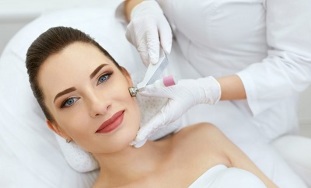
Currently, clinics offer a wide variety of cosmetic facial rejuvenation procedures. Each of them has its own special features, advantages and disadvantages
However, experts identify a number of techniques that are considered most effective and popular with patients.
The most effective treatments for facial rejuvenation
Cosmetologists identify a number of the most effective facial rejuvenation procedures, which are considered the most effective and are designed for different age groups.
Peels
This is a technique that removes dead skin cells, which helps activate the processes of regeneration and rejuvenation. As a result, the skin smoothes, straightens, increases its firmness and elasticity.
Chemicals
The mechanism of this effect is based on the formation of a controlled burn as a result of the use of synthetic or natural acid. Helps activate cell regeneration, enhance the production of elastin and collagen fibers, and improve blood flow and tissue oxygenation.
At the same time, open pores are cleansed and tightened, relief and skin tone are smoothed and wrinkles are reduced.
Depending on the severity of the age-related changes, superficial, medium or deep chemical peels may be used.
Keratoregulating
Recommended for oily skin types and considered a superficial procedure. Thanks to the ingredients that make up the composition, you can get rid of problems such as pigmentation, inflammation, acne effects, swollen pores, mimicry and medium-sized wrinkles.
The basis of these peels are hyaluronic and salicylic acid, vitamin cocktails, plant extracts, natural hormones, zinc-containing compounds.
To achieve the desired result, it is recommended to complete the full course of 7-10 procedures.
Microdermabrasion
Appropriate pieces of diamond are used to remove dead tissue. This allows the vacuum massage to be done at the same time. As a result, the skin is thoroughly cleansed and intensive rejuvenation procedures are activated.
Depending on the skin type, one of the 10 available components can be used, each with a specific particle size.
Once the skin is completely healed, there are results such as tightening, smoothing the texture and smoothing the wrinkles.
Hardware routines
These are aesthetic manipulations performed with special devices.
Photorejuvenation
The skin is exposed to light pulses that penetrate the deep layers of the skin. As a result, natural processes of collagen production are activated, which prevents and stops the appearance of signs of age-related changes in the future. Wrinkles are smoothed, the skin is improved.
In addition, photorejuvenation allows you to get rid of disadvantages such as acne and severe capillary network.
Bio-rejuvenation
This is another type of material procedure for facial rejuvenation by a beautician. For tightening, hyaluronic acid is used, which is supplied to the skin layers using injections or exposure to special equipment.
The most popular are minimally invasive methods - iontophoresis, magnetophoresis, cryotherapy and laser therapy, as well as the use of oxygen.
Ozone treatment
This type of cosmetic treatment provides the skin with an oxygen-ozone mixture, which is injected. As a result, there is an improvement in blood circulation, the metabolism is accelerated at the cellular level and its own collagen and elastin begin to be produced.
After such a procedure, the muscular framework is strengthened, wrinkles are smoothed, elasticity and healthy skin tone is restored.
RF Elevation
This process is allowed after 25 years. However, the optimal age is 35-55 years. The problem areas are affected by radio waves, which, penetrating the outer layers, provide thermal energy to the muscles and soft tissues. When heated, the skin layers begin to contract, which activates the production of collagen fibers.
Thanks to this technique, there is an improvement in skin tone, the disappearance of facial wrinkles and the alignment of the contour. The main advantages of the method are safety, pain and the absence of inflammatory processes.
Injections
Injection therapy is also a popular and effective method of facial rejuvenation. This can be the introduction of active substances and cocktails of vitamins, sausage toxin, fillers, stem cells or special threads into the layers of the skin.
The result of such manipulations is achieved quickly. The procedure is generally not accompanied by severe pain, however, with a low pain threshold or sensitive skin type, anesthesia may be used.
LPG massage
The skin is affected by a special device that performs movements with a vacuum sting. In terms of technique, this manipulation is similar to manual massage, but the effect of the former will be significantly higher.
Designed to remove wrinkles, rings, double chin, lift the area around the eyes, and restore a clean oval face.
If you do not remain supportive treatment, then the effect obtained lasts six months.
Muscostimulation
The method is based on the action of an electric current that promotes muscle contraction. As a result, blood circulation is improved, metabolic processes are normalized, skin tone is increased and wrinkles are eliminated.
To achieve the maximum result, a course of 10-15 procedures is required. The positive changes will be felt after the 4th session.
Microstimulation is indicated for women after 45 years. However, according to some indications, it can take place at a young age.
Which of the cosmetic anti-aging procedures is best to choose, only a specialist will tell you. At the same time, it always takes into account the severity of the problems associated with changes related to the age, age of the patient, the characteristics of the organism and the desired result. In addition, when choosing a technique, you should always take into account its positive and negative aspects, as well as the presence of contraindications and side effects. To avoid complications, it is recommended to apply only in proven clinics where experienced beauticians work, as well as to follow all the instructions during the postoperative period.






































